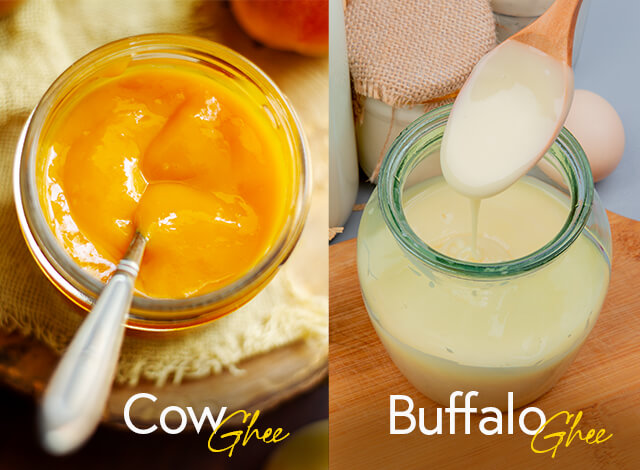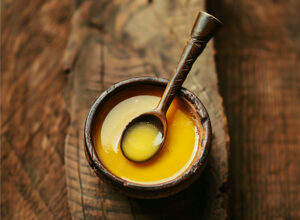What is Cow Ghee?
Made from cow’s milk, cow ghee is a clarified butter that is well-known for its silky texture and golden-yellow colour. It is a well-liked option for cooking, medicine, and skincare since it includes vital fatty acids, fat-soluble vitamins, and antioxidants. Cow ghee is a popular option for daily intake because it is lighter and easier to digest. Because of its nourishing and cleansing qualities, it is also a key component of Ayurvedic therapy.
What is Buffalo Ghee?
Buffalo milk is used to make buffalo ghee, which is white or slightly off-white in colour and thicker in substance. Compared to cow ghee, it has a higher fat content and offers more energy. Buffalo ghee is perfect for anyone with higher energy needs, such athletes or those doing heavy lifting, because of its high fat content, which causes it to take longer to digest. Because it has a longer shelf life and gives food a robust, rich flavour, it is also frequently employed in cooking.
Buffalo Ghee vs Cow Ghee
Ghee from cows and buffaloes has very different nutritional content, flavours, textures, and health advantages. Buffalo ghee is heavier and gives you more energy than cow ghee, which is lighter and easier to digest. They also differ in how they affect Ayurveda, cholesterol, and health. To assist you in making an informed decision, we have compared their attributes below.
Nutritional Composition of Ghee
For cow ghee: It contains fat-soluble vitamins A, D, E, and K, antioxidants, and important fatty acids including omega-3 and omega-6. Because it contains less fat, it is easier to digest and appropriate for daily use.
For Buffalo Ghee: Buffalo ghee is a more energy-dense choice due to its higher fat content. It has high levels of phosphorus, calcium, and magnesium, all of which promote healthy bones. But because of its high fat content, it takes longer to digest.
Chemical Composition of Ghee
For Cow Ghee: Short and medium-chain fatty acids found in cow ghee facilitate metabolism and digestion. In comparison with buffalo ghee, it contains less cholesterol.
For Buffalo Ghee: Buffalo ghee has greater levels of cholesterol and saturated fat. It contains higher conjugated linoleic acid (CLA), which should be taken in moderation but may help with weight management.
Health Benefits of Ghee
For Cow Ghee: It is well recognized to strengthen immunity, facilitate better digestion, and increase cognitive function. It is utilized in Ayurvedic cleansing therapies and has anti-inflammatory qualities.
For Buffalo Ghee: Buffalo ghee is good for people who are physically active and gives them greater energy. Because of its high mineral content, it also helps to build bones, but only in moderation.
Also Read: 15 Amazing Benefits of Ghee
Ghee Colour
For Cow Ghee: Beta-carotene, a precursor to vitamin A, gives cow ghee its golden-yellow hue.
For Buffalo Ghee: Because buffalo milk lacks beta-carotene, buffalo ghee appears white or slightly off-white.
Milk to Ghee Ratio
For Cow Ghee: Since cow milk has a lower fat content, more milk is needed to produce cow ghee.
For Buffalo Ghee: Because buffalo milk has more fat, a lesser amount of milk can produce more ghee.
Shelf Life
For Cow Ghee: Because it contains less fat, cow ghee has a shorter shelf life.
For Buffalo Ghee: Buffalo ghee is better suited for storage without refrigeration due to its longer shelf life.
Weight Management
For Cow Ghee: When taken in moderation, the CLA in cow ghee may help with weight management and fat metabolism.
For Buffalo Ghee: If ingested in excess, buffalo ghee’s increased fat content could lead to weight gain.
Cholesterol
For Cow Ghee: Cow ghee is a better option for heart health because it contains less cholesterol.
For Buffalo Ghee: If ingested in excess, buffalo ghee’s increased cholesterol content may raise the risk of cardiovascular problems.
Ayurvedic perspective
For Cow Ghee: According to Ayurveda, cow ghee is “Satvik,” which is good for digestion, mental clarity, and general health.
For Buffalo Ghee: Buffalo ghee is regarded as “Tamasik,” which means it is heavier and best suited for people who are more physically active.
Bone Health
For Cow Ghee: Vitamin D, which promotes calcium absorption and fortifies bones, is present in cow ghee.
For Buffalo Ghee: It effectively increases bone density since it is higher in calcium and phosphorus.
Digestion
For Cow Ghee: Better for people with sensitive digestion, easier to digest, and beneficial to gut health.
For buffalo ghee: It takes longer to digest and might not be appropriate for people with weak digestive systems.
Consumption by the Elderly
For cow ghee: Because of its easier digestion and lighter consistency, it is advised for senior citizens.
For Buffalo Ghee: Due to its increased fat content, buffalo ghee may be more difficult for older people to digest.
AVT’s Takeaway
Depending on individual health objectives, both cow and buffalo ghee have special advantages. While buffalo ghee has a longer shelf life and more energy, cow ghee is better for digestion and overall health. To get their benefits without suffering negative consequences, moderation is essential.
FAQs
-
Why is Cow Ghee Better than Buffalo Ghee?
Cow ghee is easier to digest, has lower cholesterol, and offers more Ayurvedic benefits, making it a healthier option for daily use.
-
Which is better cow ghee or buffalo ghee?
Cow ghee is better for digestion and heart health, while buffalo ghee is ideal for higher energy needs.
-
What is the best type of ghee?
Cow ghee is generally considered the best for overall health, digestion, and Ayurveda benefits.
-
Is buffalo ghee hard to digest?
Yes, due to its high-fat content, buffalo ghee takes longer to digest than cow ghee.
-
Which ghee is tasty cow or buffalo?
Taste preferences vary, cow ghee has a mild, aromatic flavour, while buffalo ghee is richer and denser.
-
Which ghee should be given to babies?
Cow ghee is recommended for babies due to its easy digestibility and nutritional benefits.









